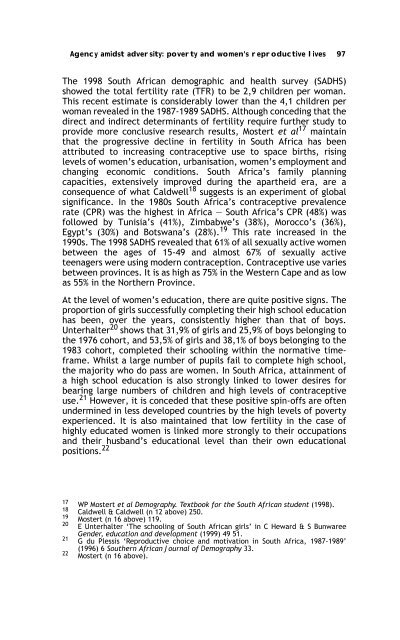Sex, Gender, Becoming - PULP
Sex, Gender, Becoming - PULP
Sex, Gender, Becoming - PULP
Create successful ePaper yourself
Turn your PDF publications into a flip-book with our unique Google optimized e-Paper software.
Agency amidst adversity: poverty and women’s reproductive lives 97<br />
The 1998 South African demographic and health survey (SADHS)<br />
showed the total fertility rate (TFR) to be 2,9 children per woman.<br />
This recent estimate is considerably lower than the 4,1 children per<br />
woman revealed in the 1987-1989 SADHS. Although conceding that the<br />
direct and indirect determinants of fertility require further study to<br />
provide more conclusive research results, Mostert et al 17 maintain<br />
that the progressive decline in fertility in South Africa has been<br />
attributed to increasing contraceptive use to space births, rising<br />
levels of women’s education, urbanisation, women’s employment and<br />
changing economic conditions. South Africa’s family planning<br />
capacities, extensively improved during the apartheid era, are a<br />
consequence of what Caldwell 18 suggests is an experiment of global<br />
significance. In the 1980s South Africa’s contraceptive prevalence<br />
rate (CPR) was the highest in Africa — South Africa’s CPR (48%) was<br />
followed by Tunisia’s (41%), Zimbabwe’s (38%), Morocco’s (36%),<br />
Egypt’s (30%) and Botswana’s (28%). 19 This rate increased in the<br />
1990s. The 1998 SADHS revealed that 61% of all sexually active women<br />
between the ages of 15-49 and almost 67% of sexually active<br />
teenagers were using modern contraception. Contraceptive use varies<br />
between provinces. It is as high as 75% in the Western Cape and as low<br />
as 55% in the Northern Province.<br />
At the level of women’s education, there are quite positive signs. The<br />
proportion of girls successfully completing their high school education<br />
has been, over the years, consistently higher than that of boys.<br />
Unterhalter 20 shows that 31,9% of girls and 25,9% of boys belonging to<br />
the 1976 cohort, and 53,5% of girls and 38,1% of boys belonging to the<br />
1983 cohort, completed their schooling within the normative timeframe.<br />
Whilst a large number of pupils fail to complete high school,<br />
the majority who do pass are women. In South Africa, attainment of<br />
a high school education is also strongly linked to lower desires for<br />
bearing large numbers of children and high levels of contraceptive<br />
use. 21 However, it is conceded that these positive spin-offs are often<br />
undermined in less developed countries by the high levels of poverty<br />
experienced. It is also maintained that low fertility in the case of<br />
highly educated women is linked more strongly to their occupations<br />
and their husband’s educational level than their own educational<br />
positions. 22<br />
17<br />
WP Mostert et al Demography. Textbook for the South African student (1998).<br />
18 Caldwell & Caldwell (n 12 above) 250.<br />
19 Mostert (n 16 above) 119.<br />
20<br />
E Unterhalter ‘The schooling of South African girls’ in C Heward & S Bunwaree<br />
21<br />
<strong>Gender</strong>, education and development (1999) 49 51.<br />
G du Plessis ‘Reproductive choice and motivation in South Africa, 1987-1989’<br />
22<br />
(1996) 6 Southern African Journal of Demography 33.<br />
Mostert (n 16 above).
















